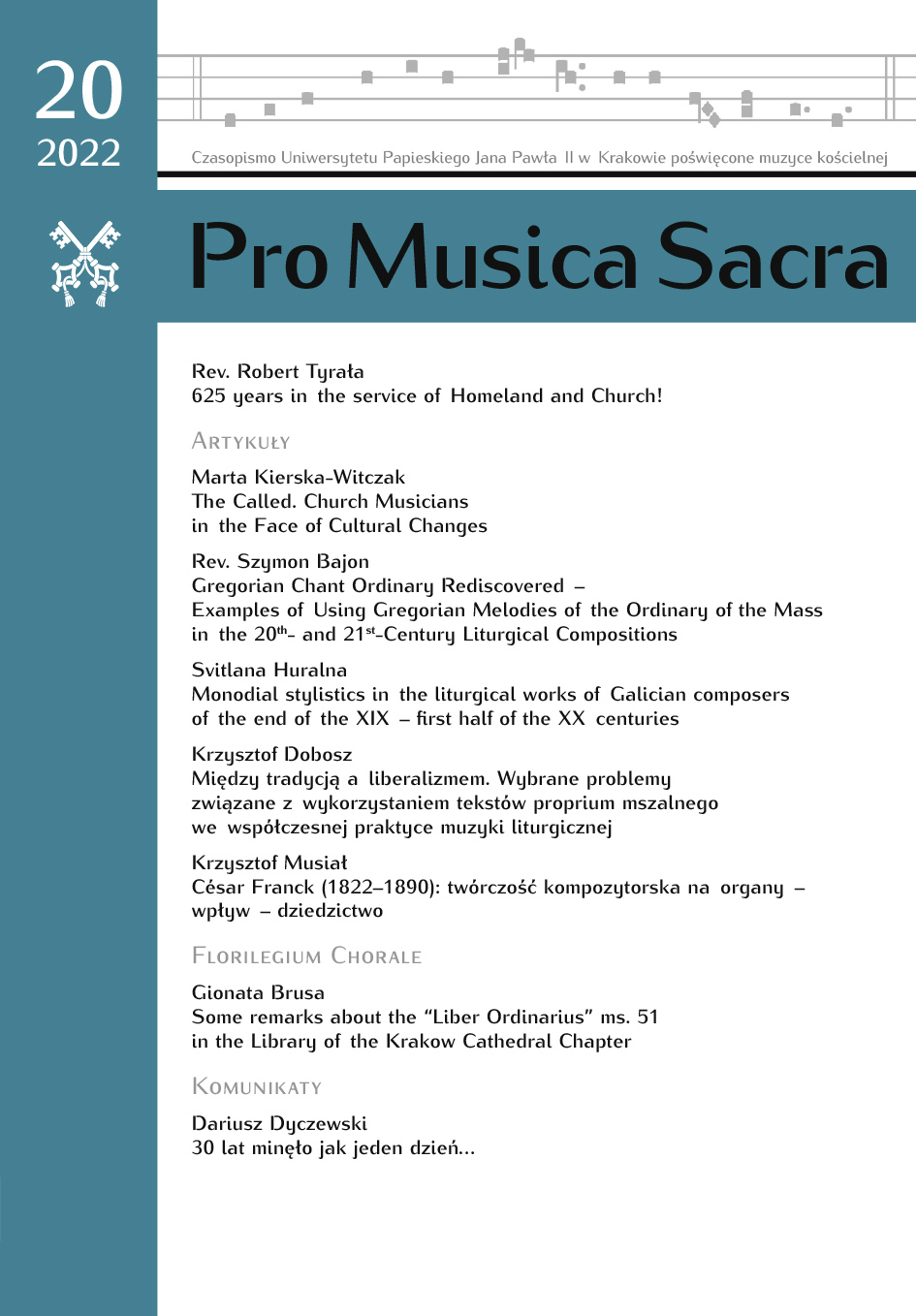Monodial stylistics in the liturgical works of Galician composers of the end of the XIX – first half of the XX centuries
DOI:
https://doi.org/10.15633/pms.2003Keywords:
Galicia, composer, church-singing traditions, liturgy, chants, monodyAbstract
The article draws attention to the historical and social processes that influenced the peculiarities of the development of Ukrainian culture, in particular, formed the specifics of church-educational life and liturgical-choral practice of Galicia in the late nineteenth and first half of the twentieth centuries. The close cooperation of the spiritual and artistic elite was emphasized, which resulted in the improvement of the level of art education, intensification of the activities of numerous choral societies and composers. Based on the analysis of the liturgical works of P. Bazhansky, V. Matyuk, J. Kishakevych, S. Liudkevych, the prerogatives of the author’s composition in the use of monody style were revealed.
References
B. a. (Without the author), O instytutakh dlya obrazovanya and education dyakov, in: Halytska Rus, Dyakovskiy Hlas, Stanyslavov 1899, Č. 1, p. 5–7.
Antonjuk-Gural’na S., Liturgija, ukladena Stanislavom Ljudkevičem: stilistični osoblivosti, in: Naukovi zapiski Ternopil’s’kogo nacional’nogo pedagogičnogo universitetu imeni Volodimira Gnatjuka, Ternopil 2012, p. 101–109 (Mistectvoznavstvo, 1).
B. n. (Without the author), Galičanin, 1899, 14/26 sičnja, Č. 10, p. 3.
Bažans’kij P., Druga liturgija starovinnix napiviv na čotiri mišani golosi dlja sil i mistečok, Peremišl’ 1907.
Bažans’kij P., Perša liturgija starovinnix napiviv na čotiri mišani golosi dlja sil i mistečok, L’viv 1907.
Bažans’kij P., Tretja liturgija starocerkovnix napiviv na čotiri mišani golosi dlja sil i mistečok dlja mišanogo xoru, Peremišl’ 1911.
Bažans’kij P., Četverta liturgija starocerkovnix napiviv na čotiri mišani golosi dlja sil i mistečok, Peremišl’ 1911.
Gyral’na S., Muzično-stilističnij semioz Liturgij Porfirija Bažans’kogo, in: Naukovi zapiski Terno-pil’s’kogo nacional’nogo pedagogičnogo universitetu imeni Volodimira Gnatjuka, Ternopil 2013, p. 116–124 (Mistectvoznavstvo, 1).
Gural’na C., Liturgija iz Spivanika (1911) V. Matjuka ta ii vpliv na cerkovnu muzičnu kul’turu Sxidnoi Galičini, in: Mistectvoznavči zapiski, Vip. 24, Kiiv 2013, p. 40–46.
Zvaričuk Ž., Bogoslužbove xorove vikonavstvo Galičini XIX stolittja, Kiiv 2009.
Kišakevič J., Služba Boža po zaxidno-ukrains’komu cerkovno-narodn’omu napivu na mišanij xor, Duxovno-muzični tvori J. Kišakeviča, Č. 21, L’viv, bez dati, p. 32.
Kijanovs’ka L., Stil’ova evoljucija galic’koi muzičnoi kul’turi XIX-XX st., Ternopil’ 2000.
Kudrik B., Ogljad istorii ukrains’koi cerkovnoi muziki, 1: Doslidnic’ka robota, L’viv 1995, p. 8–128 (Istorija ukrains’koi muziki).
Ljudkevič C., Sprava našogo cerkovnogo spivu, “Ukrains’kij visnik” 1921, 2 serp – Čč. 150–151, p. 2–3.
Ljudkevič S., Doslidžennja, statti, recenzii, vistupi, Vip. 2, Uporjadkuvannja, redaguvannja, perekladi, primitki ta bibliografija Z. Štunder, L’viv 2000, p. 244–248.
Ljudkevič S., Liturgija: Zbirnik liturgičnix i cerkovnix pisen’ na osnovi narodnix napiviv na mišanij xor, L’viv 1922.
Popovič O., Ukrains’ke muzične žittja Peremišlja (1919–1999), Kiiv 2003.
Sirotins’ka N., Bilja vitokiv greko-vizantijs’koi gimnografii ta cerkovnoi monodii, in: Kiivs’ke muzi-koznavstvo. Kul’turologija ta mistectvoznavstvo. Zbirka statej, Vip. 36, Kiiv 2011, p. 10–18.
Tološnjak N., Sistema muzičnoi osviti v navčal’no-vixovnix zakladax «Ridnoi školi», “Musica Galiciana” (Muzika Galičini), L’viv 1999, p. 171–180.
Turula Ju., Neobxidnist’ reformuvannja liturgijnogo spivu v galic’kix greko-katolic’kix cerkvax, Ruslan, L’viv 1913.
Čerepanin M., Muzična kul’tura Galičini (druga polovina XIX – perša polovina XX st.), Kiiv 1997.
Downloads
Published
Issue
Section
License
Copyright (c) 2022 Svіtlana Huralna

This work is licensed under a Creative Commons Attribution 4.0 International License.
Authors who publish with this journal agree to the following terms:
- Authors retain the copyright and full publishing rights without restrictions, and grant the journal right of first publication with the work simultaneously licensed under a Creative Commons Attribution 4.0 International License that allows others to share the work with an acknowledgement of the work's authorship and initial publication in this journal.
- Authors are able to enter into separate, additional contractual arrangements for the non-exclusive distribution of the journal's published version of the work (e.g., post it to an institutional repository or publish it in a book), with an acknowledgement of its initial publication in this journal.
- Authors are permitted and encouraged to post their work online (e.g., in institutional repositories or on their website) prior to and during the submission process, as it can lead to productive exchanges, as well as earlier and greater citation of published work (See The Effect of Open Access).

